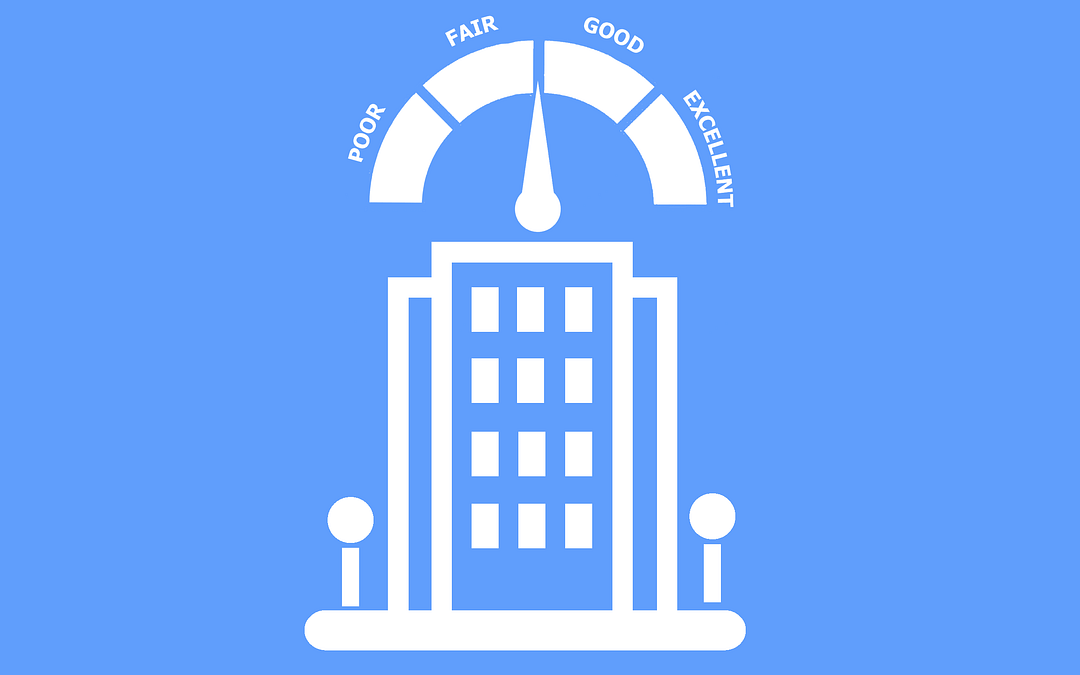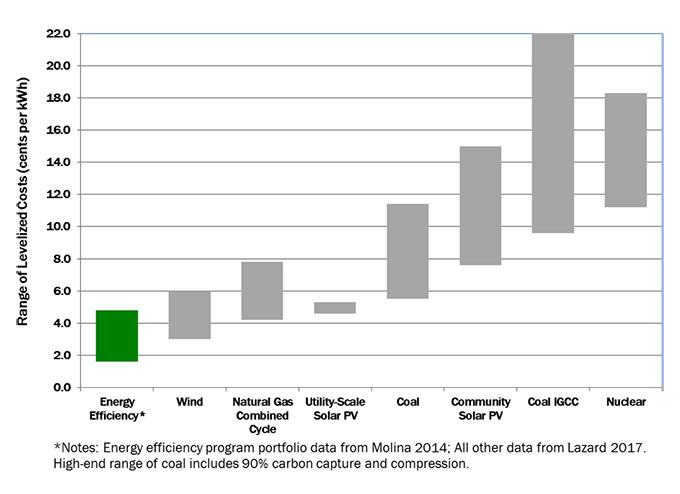Imagine it’s May 1st. We’ve hopefully gotten through the worst of this pandemic, but you are still playing catchup after coordinating a new disinfection service for the common areas of your property. In your mail you find a “Notice of Violation” from DC’s Office of Energy and Environment. You open the envelope to learn that you have failed to report your benchmarking numbers and are now subject to a $100/day fine from the City. Whoa!
This begs the question: What the heck is benchmarking?
Benchmarking is the reporting of energy and water data to the authority having jurisdiction. The purpose is to give them a tool for diagnosing inefficient buildings. This will allow them to better tailor local policies to improve building performance. This is a critical step in creating a clean energy economy, as the American Council for an Energy Efficient Economy estimates that energy efficiency projects are about 4 times more cost effective than producing electricity through solar PV – see chart below.
In addition to giving your local government a tool, Energy Benchmarking also provides your Association with a tool to identify weak spots in your building’s performance and to proactively manage it while reducing your energy expenses. Simply measuring and creating awareness of your building’s energy use can lead to significant reductions in energy expenses. That’s an immediate win.
In DC, buildings above 50,000 sq ft are required to submit their Benchmark Reports to the District by April 1st every year. Starting in 2022, all buildings above 25,000 sq ft will be required to benchmark, and by 2025, all buildings over 10,000 sq ft will be required to benchmark, as mandated under the Clean Energy DC Omnibus Act. The penalty for non-compliance in the District is $100 per day.
In Maryland, only Montgomery County requires benchmarking and it only applies to Nonresidential buildings, or groups of buildings that have the same tax ID, that are above 50,000 sq ft. These properties must submit their annual Benchmarking Reports by June 1st. The penalty for non-compliance in Montgomery County is $500 for an initial violation and $750 for repeated violations.
In Virginia, there is currently only a mandate for municipal buildings, similar to DC’s initial requirements. If it continues to follow the path of DC, this mandate could soon expand to cover additional properties, though no bills or regulations have been proposed to do so at this time.
So what are the nuts and bolts of reporting? All data must be entered through Energy Star’s Portfolio Manager, which is facilitated through the U.S. Environmental Protection Agency. This software requires you to identify various aspects of your property, including:
- Property type;
- Gross floor area;
- Number of workers/residents;
- Appliance Information;
- Hours of Operation; and
- Other attributes depending on the property type.
It then requires you to enter usage data for electric, natural gas, and water. Once this information is entered, the platform rates your property based on all other similar properties in the database – adjusting for climate zone. This rating is scored 1 to 100, with 100 meaning your property is in the top percentile of efficiency compared to similar building types, sizes, etc. As such, your score can go down even if your building remains the same, if the average building in the data set becomes more efficient.
The Energy Star Score is very important as states and municipalities will begin to use these scores to crack down on inefficient buildings. Beginning in 2021, DC will require buildings above 50,000 sq ft to have scores above DC’s median Energy Star score – currently at 64 for multifamily buildings. This threshold will lower to 25,000 sq ft in 2027 and 10,000 sq ft by 2033.
Buildings that do not meet the required standard will be placed in a 5-year compliance cycle. The building owner (Condominium or Cooperative Association) has until the end of the cycle to bring their building into compliance.
What you can do now:
- Double check your benchmarking data to make sure everything is accurate;
- Compare 2019 scores to the 2018 multifamily median score (64) to get a sense of how your building is performing;
- Begin to identify solar opportunities and energy efficiency measures that can help increase your Energy Star score;
- Engage with your Association;
- Create an internal team to start aligning energy actions;
- And start developing a strategic energy management plan.
Many buildings have square footage hidden away that could be converted to additional savings without any capital outlay – empty roofs. Reducing your energy load through onsite solar will increase your building’s Energy Star score. There is currently a ‘green rush’ in the DC solar market. In exchange for the solar incentives, solar companies in DC are offering to cover 100% of installations, handle all maintenance efforts, and compensate the building owner by providing significantly lower rates for the solar energy produced from the system than what your Associations are currently paying through Pepco. Solar companies are also offering to provide additional funds towards roof replacements or other building upgrades. With federal incentives scheduled to decline in 2021 and a potential peak in local incentives, solar panel supply is becoming scarce.
With generous utility rebates from DCSEU and other local utilities in the DMV region and falling manufacturing costs, retrofitting to LEDs has never been a better value. LED retrofit projects typically have a 3-year payback period and IRRs of 20-40%. Not only will it help improve your energy performance and reduce operating budgets, it will also increase your building’s Energy Star score. Some LED companies are also offering an off-balance sheet, shared-savings program where Associations simply share a percentage of their savings with the lighting provider each month over a 5-year period including a maintenance service.
We don’t know what’s going to happen with these incentives in the future, but every year these projects are deferred, the maintenance costs on inefficient systems increase and utility expenses continue to bleed your building’s budgets. As such, the sooner you benchmark and implement energy conservations measures, the more your community will benefit from your efforts.
Still feeling overwhelmed by these requirements? Honeydew is here to help. We’ll take care of all the legwork in creating a profile in Portfolio Manager, ensuring that your information is being accurately reported each year, and providing free consultation on how to increase your Energy Star score so you don’t get penalized for non-compliance. Interested? Drop us a line in the chat function or email form on the website below!


